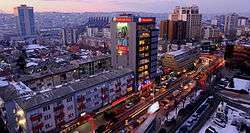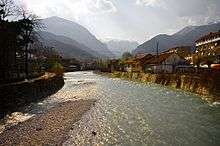Klina
| Klina | |
|---|---|
| Municipality and city | |
| Klina (Klinë) / Klina (Клина) | |
 | |
 Klina Location in Kosovo | |
| Coordinates: 42°37′N 20°34′E / 42.617°N 20.567°E | |
| Country | Kosovo |
| District | District of Peć |
| Area | |
| • municipality | 309 km2 (119 sq mi) |
| Elevation | 382 m (1,253 ft) |
| Population (2014) | |
| • municipality | 39,527 |
| • Density | 130/km2 (330/sq mi) |
| Time zone | CET (UTC+1) |
| • Summer (DST) | CEST (UTC+2) |
| Postal code | 32000 |
| Area code(s) | +381 |
| Car plates | 03 |
| Website | kk.rks-gov.net/kline |
Klina or Klinë (Albanian: Klina or Klinë; Serbian: Клина, Klina) is a city and municipality in the Peć district of north-western Kosovo.[lower-alpha 1] It is located at the confluence of the river Klina into the White Drin.
History
Klina is shown to be inhabited since ancient times. First mentioning comes from Ptolemy which mentions Chinna, residing close to Narona and 12 miles from Shkodër, both listed as part of Dalmatia.[1][2] Newer sources mention it populated by the Illyrian tribe of Dardani.[3][4] There are also sources who place the hypotheses of a Celtic settlement in Illyricum, and a possible Celtic explanation of the name.[5] During Early Middle Ages, Porphyrogenitus mentions the urban center of Desstinik, today Dersnik/Drsnik, where important archeological discoveries of Roman period were made in August 2013, described as: ...the most important discovery of the past few decades to have been made in Kosovo in the area of archaeology.[6]
Symbol
A symbol of Klina are the Mirusha Waterfalls.
Demographics
| Ethnic Composition | |||||||||||||
| Year/Population | Albanians | % | Serbs | % | Montenegrins | % | Roma | % | Total | ||||
|---|---|---|---|---|---|---|---|---|---|---|---|---|---|
| 1961 | 18,124 | 66.75 | 7,378 | 27.17 | 1,372 | 5.05 | 80 | 0.29 | 27,153 | ||||
| 1971 | 33,050 | 78.04 | 7,864 | 18.57 | 1,157 | 2.73 | 118 | 0.28 | 42,351 | ||||
| 1981 | 45,594 | 83.60 | 6,829 | 12.52 | 973 | 1.78 | 798 | 1.46 | 54,539 | ||||
| 1991 | 43,248 | 82.75 | 5,209 | 9.97 | 621 | 1.19 | 1,278 | 2.45 | 52,266 | ||||
| January 1999 | 55,000 | 78.6 | 10,000 | 14.3 | 5,000 | 7.1 | 70,000 | ||||||
| 2006 | 53,000 | 96.5 | 94 | 0.17 | 1,800 | 3.3 | 54,900 | ||||||
| Ref: Yugoslav Population Censuses for data through 1991, Organization for Security and Co-operation in Europe estimates for 1999 and 2006 | |||||||||||||
In September 2014, 12 Egyptian families returned to Klina having spent the last 15 years displaced in Podgorica, Montenegro. The families moved straight into a newly constructed neighbourhood as part of project helping refugees from the Kosovo War return to Kosovo.[7]
Notable people
- Anton Berisha, folklorist and scholar
See also
Annotations
- ↑ Kosovo is the subject of a territorial dispute between the Republic of Kosovo and the Republic of Serbia. The Republic of Kosovo unilaterally declared independence on 17 February 2008, but Serbia continues to claim it as part of its own sovereign territory. The two governments began to normalise relations in 2013, as part of the Brussels Agreement. Kosovo has received recognition as an independent state from 110 out of 193 United Nations member states.
References
- ↑ Ptolemy: Book 2, Chapter V
- ↑ Alexander MacBean (May 5, 2013), A Dictionary of Ancient Geography Explaining the Local Appellations in Sacred, Grecian, and Roman History, Book on Demand Ltd., ISBN 978-5518411340, retrieved 2013-10-27
- ↑ Gail Warrander, Verena Knaus (2008). Kosovo: the Bradt travel guide. Bradt Travel Guides. p. 166. Retrieved 2013-08-18.
- ↑ Historiku (History) (in Albanian), Municipality of Klina
- ↑ Robinson Ellis (June 25, 2009), A Commentary on Catullus, Cornell University Library, p. 393, ISBN 978-1112066672, retrieved 2013-10-27
- ↑ Archaeological discoveries in Dresnik of Klina, the most intriguing discovery of the past few decades, Ministry of Culture, Youth, and Sport of Kosovo, 2013-08-15
- ↑ "Egyptians return to Kosovo after 15 years of displacement". Shanghai Daily. 15 September 2014. Retrieved 16 September 2014.
External links
 Media related to Klina at Wikimedia Commons
Media related to Klina at Wikimedia Commons- Komuna Klina
| | |||||||||
|---|---|---|---|---|---|---|---|---|---|
| Rank | Name | Districts | Pop. | Rank | Name | Districts | Pop. | ||
 Pristina Prizren |
1 | Pristina | Pristina | 210,722 | 11 | Glogovac (Drenas) | Pristina | 61,522 |  Ferizaj (Uroševac)  Peć |
| 2 | Prizren | Prizren | 186,860 | 12 | Lipljan | Pristina | 60,517 | ||
| 3 | Ferizaj (Uroševac) | Ferizaj (Uroševac) | 114,087 | 13 | Orahovac | Gjakova | 59,021 | ||
| 4 | Peć | Peć | 100,081 | 14 | Mališevo | Prizren | 58,198 | ||
| 5 | Gjakova | Gjakova | 98,240 | 15 | Skenderaj (Srbica) | Mitrovica | 52,951 | ||
| 6 | Gjilan | Gjilan | 93,291 | 16 | Vitina | Gjilan | 48,861 | ||
| 7 | Podujevo | Pristina | 91,642 | 17 | Deçan | Peć | 41,523 | ||
| 8 | Mitrovica | Mitrovica | 85,910 | 18 | Istok | Peć | 40,935 | ||
| 9 | Vučitrn | Mitrovica | 72,780 | 19 | Klina | Peć | 40,675 | ||
| 10 | Suva Reka | Prizren | 62,913 | 20 | Kosovo Polje (Fushë Kosova) | Pristina | 38,265 | ||
Coordinates: 42°37′18″N 20°34′40″E / 42.62167°N 20.57778°E
